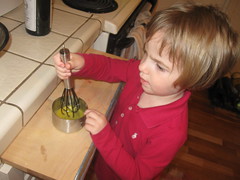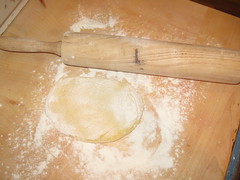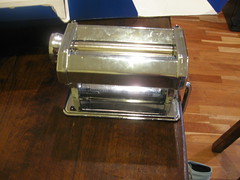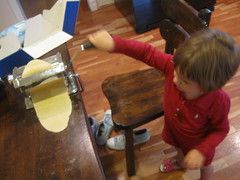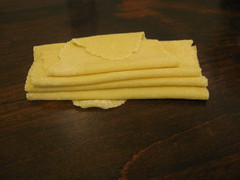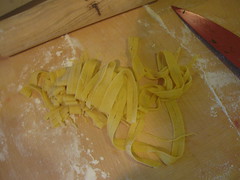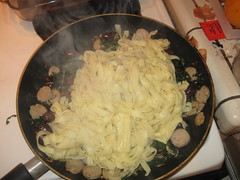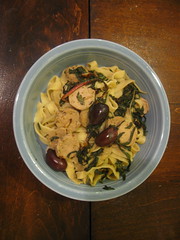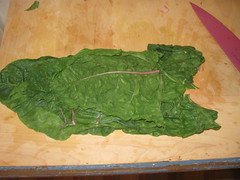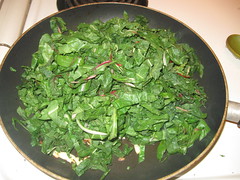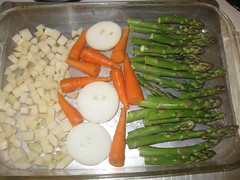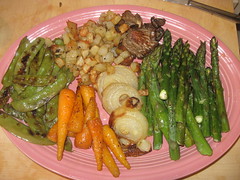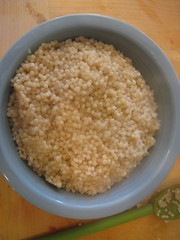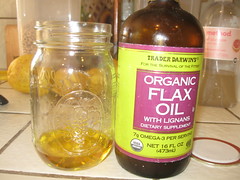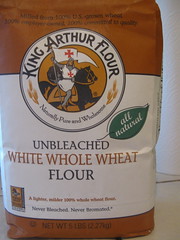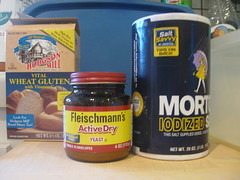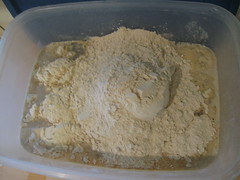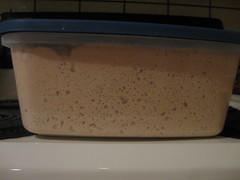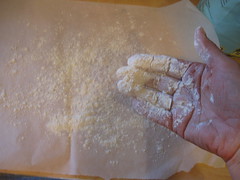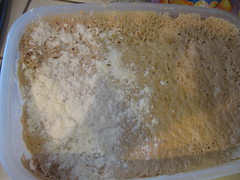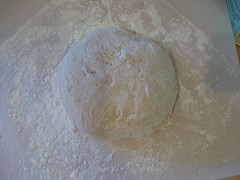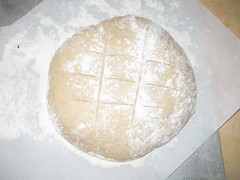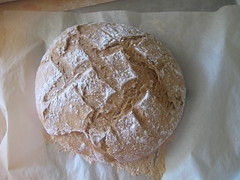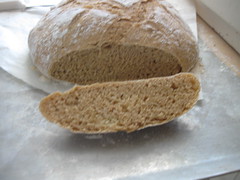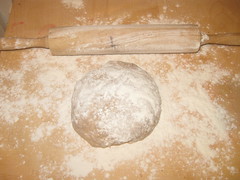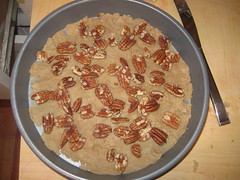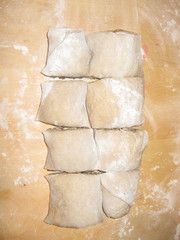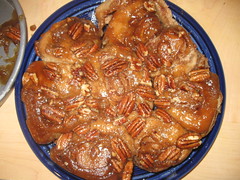I went this week to La Superior Mercado, which, as you might have guessed, carries Hispanic foods. I love looking around, and I settled on a few items: a chayote squash, a bag of tomatillos, a small watermelon, some chili-spiced mango (just for a snack), a jicama, and a bag of nopalitos (cactus), pre-spined and diced. My total bill was just over $7. On another trip, I had seen a bag of "soya texturizada," and although I only speak enough Spanish to understand Speedy Gonzales, even I could figure that out -- TVP! It was a little less than at the hippie store, so I picked that up, too.

Just for fun, my family periodically studies another country or culture, so we've been eating Mexican food all week -- tamales (store-bought), refried beans (recipe below), a sort of Southwest-y salad -- but tonight I was going to do it up.
In the morning, I made watermelon liquados.
Watermelon liquados
1 personal-sized watermelon (preferably seedless)
1 Tbs crushed ginger
1/4 cup lime juice
water
I took all the watermelon out of the rind and threw it in the blender. Then I added about 2 cups of water, the ginger and lime juice. I blended it all to hell, then strained it into a bowl. I poured it into a pitcher and put it in the fridge until later. It was delicious and refreshing. I saw several similar recipes online, and all of them added sugar "to taste." I tasted it and felt it didn't need any sugar, but you do what you like.
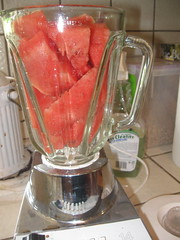
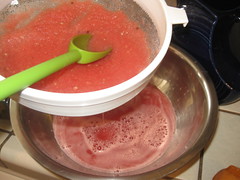
I also started my refried beans, which I make in a slow cooker. These are such a hit in my house that we have them once a week.
Refried beans
2 cups dry pinto beans
1 onion
1 fresh jalapeno, diced OR 2 dried chipotle or de Arbol chiles, whole
1 Tbs cumin
2 Tbs salt
9 cups water
Peel the onion, cut the stem end off, and cut it in half. Add everything else to the slow cooker and turn it on "high." Leave it alone for about 9 hours (anywhere from 8-10 is fine). Drain most off the water off, remove the dried chiles if you used them, then mash with a potato masher. Done.
This recipe is pretty flexible -- you can put it in the slow cooker the night before to soak, then turn it on in the morning, or you can assemble it in the morning. You can use fresh or dried chiles, and any kind of onion. I was worried the first time I left it on High all day, because almost all the rest of my slow-cooker recipes call for the thing to be left on Low, but High is just perfect and won't burn your kitchen down, I swear.
Your bonus tip this week is "Get to know a measurement." I don't recommend this for baking, because baking is like science, but it works for most other cooking. Figure out how much a tablespoon is -- measure one out and dump it in the palm of your hand -- and then estimate it from now on. How much is 1/4 cup of water? What does it look like? If you can get to know some basic measurements, it'll cut down on the time it takes to cook as well as the dishes to clean up afterward.
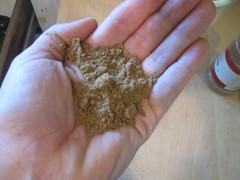
One tablespoon of cumin.
After I turned the beans on, we spent the day at the fair. When we came home, I started cooking for real.
Tomatillo salsa
20 tomatillos, mixed sizes
1 red onion
2 serrano peppers
2 cloves garlic
1/2 cup loosely packed cilantro
lime juice
salt to taste

Remove the papery skins from the tomatillos, and cut into chunks (I cut the small ones into quarters and the big ones into eighths).
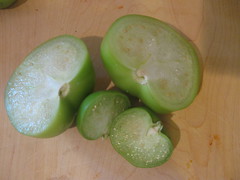
Put them on a cookie sheet, jelly roll pan, roasting pan, or whatever. I didn't want to clean it later, so I lined it with foil first.
Cut the onion into quarters and add to the pan. Then halve the peppers and remove the stems (I would leave the seeds in -- this was a fairly mild salsa) and add them as well.
I cooked it at a low broil. If you only have one option for broil, and that option is "nuclear," then roast at a high temperature, like 500, instead. I checked mine after 5 minutes and shook them around, then took them out after ten minutes when there were some nice dark brown bits.
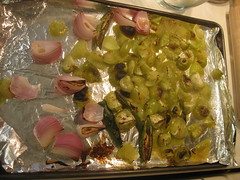
Then I added the entire contents of the pan to my blender, threw in the garlic, added about 2 Tbs of lime juice, 1 Tbs salt, and the cilantro, then whirled it around until it was pretty.
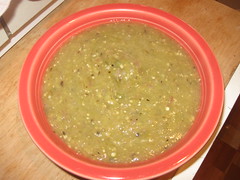
My daughter even liked it, and she really balks at spicy foods, so don't worry about the serranos.
Veggie tacos
1 cup nopales, spines removed and diced
1 cup TVP
1 package taco seasoning (or feel free to use the spices -- I was being lazy)
hot water (about 2 cups)
In a bowl, soak the TVP in 1 cup of water. Put a little oil or cooking spray in a large pan over medium heat. Add the TVP and nopales, then the seasoning and additional water. It won't brown in the same way that meat will, but it will heat through, the nopales will get tender, and the seasoning will get mixed evenly.
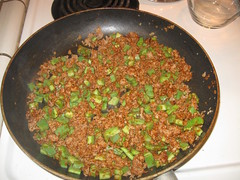
Chayote squash
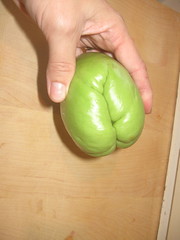
(I consulted this recipe)
1 Tbs olive oil
1 chayote
1/2 tsp salt
1 packet Splenda (or 1/2 tsp sugar)
1 Tbs lime juice
Peel and julienne the squash. Heat a small pan over medium-high heat and add the oil. Then add squash, salt, and sugar or sweetener. Saute, stirring frequently, for about 3 minutes, then add the lime juice and saute for about three more minutes. Serve.
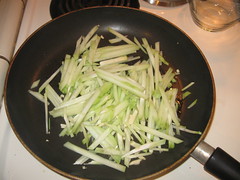
Like my knife skills?

Just kidding -- I have one of these and no appreciable "knife skills."
In a previous post, I advised you to check the comments on a recipe. I substituted lime juice on the advice of the commenters, and did the Splenda for that reason as well (actually, that was at least partly because I'm very, very lazy, and I'd have had to open a new bag of sugar). I left out the garlic because I was in a hurry, and I left out the pepper because my daughter is sensitive to spice. I had never tried chayote before, so I consulted the recipe because I didn't want to totally screw it up. As it turned out, my husband loved it, and said he'd prefer it to zucchini anytime.
Almost done!
I said it was taco night, right? So I diced a few tomatoes and three avocados. I set out shredded cheese. I shredded some iceberg lettuce (the one time I really love it is on tacos, for its crunch), and I warmed some corn tortillas. Then it was up to everyone to make their own tacos.
I ate the chayote as a side dish, whereas the husband put it on his tacos. The kid declared that she liked cactus, but wanted more fake meat. We all liked the salsa and liquados. If you don't count the prep work did in the morning for the beverage and the beans, this was a meal that I got on the table in less than 90 minutes, even though I made the salsa, taco filling, and side dish and mashed the beans. I mentioned before that I'm no Martha Stewart, and I guess I'm no Rachel Ray (whose show is called "30 Minute Meals"), either, but it wasn't a work night. I cook a lot faster on work nights.
Anyway, happy cooking! I called this part 1 of "Get to know an ethic market" because, well, let's just say I'm very lucky to live where I do, and more ethnic market posts are on the way.
